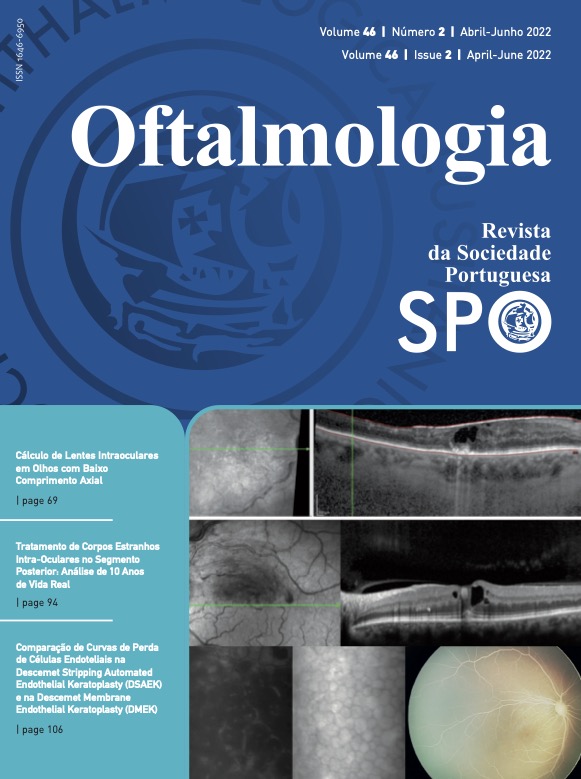Strabismus Surgery for Abnormal Head Position: 7-Year Experience at a Tertiary Care Center
DOI:
https://doi.org/10.48560/rspo.25975Keywords:
Duane Retraction Syndrome, Head, Nystagmus, Congenital, Ocular Motility Disorders, Posture, Strabismus/surgery, TorticollisAbstract
INTRODUCTION: Traditionally, the goal of strabismus treatment has been to realign the visual axes in order to eliminate diplopia, to produce, maintain, or restore binocular vision or for aesthetic reasons. Nowadays, surgery to improve an abnormal head position (AHP) is also a well-accepted indication for surgery. AHP or torticollis is a frequent encountered sign in routine ophthalmology practice, especially in pediatric patients. The present study aims to characterize the patients of a tertiary hospital who were submitted to surgery for an AHP caused by an ocular condition, as well as the results obtained by the treatment provided to them.
MATERIAL ANd METHODS: The medical records of patients who were admitted to surgery for an AHP in the Ophthalmology department of Centro Hospitalar Universitário de São João between July 2014 and July 2021 were retrospectively studied. The patients underwent ophthalmologic examinations pre and post-operatively. Characterization of the AHP was subjectively evaluated.
RESULTS: In total, 24 patients were studied, 8 (33.3%) of whom were female and 16 (66.6%) were male. Mean age of patients was 13.7 years (range 3-61 years). There were 7 patients with superior oblique palsy, 7 patients with Duane syndrome (type 1), 6 patients with nystagmus, 3 patients with third nerve paralysis and 1 patient with Brown syndrome. Face turn was the most frequent AHP (14 patients), followed by head tilt AHP (5 patients). Four patients had mixed AHP (head tilt and face turn) and 1 patient presented with chin up. A total of 95.8% of patients had their AHP improved with surgical treatment. Nineteen patients were submitted to one surgery and a second surgery was necessary in 5 patients.
CONCLUSION: Overall, almost all patients improved after surgery. Nevertheless, it is important to highlight that occasionally it is necessary more than one surgery to achieve the best result,
Downloads
References
Paysse EA. Adult strabismus: goals of realignment surgery. Binocul Vis Strabismus Q. 2001;16:9-10.
Cooperman DR. The differential diagnosis of torticollis in children. Phys Occup Ther Pediatr. 1997;17:1–11.
Nucci P, Curiel B. Abnormal head posture due to ocular problems- a review. Curr Pediatr Rev. 2009;5:105–11.
Kushner BJ. Ocular causes of abnormal head postures. Ophthalmology. 1979;86:2115–25.doi: 10.1016/S01616420(79)35301-5
Berlin H. The differential diagnosis and management of torticollis in children. Phys Med Rehabil. 2000;14:197–206.
Boricean I-D, Bărar A. Understanding ocular torticollis in children. Oftalmologia. 2011;55:10–26.
Akbari MR, Khorrami Nejad M, Askarizadeh F, Pour FF, Ranjbar Pazooki M, Moeinitabar MR. Facial asymmetry in ocular torticollis. J Curr Ophthalmol. 2015;27:4–11. doi: 10.1016/j. joco.2015.10.005.
Khawam E, el Baba F, Kaba F. Abnormal ocular head postures: Part IV. Ann Ophthalmol. 1987;19:466–72.
Elliott RL, Nankin SJ. Anterior transposition of the inferior oblique. J Pediatr Ophthalmol Strabismus. 1981;18:35–8.
Scott A. Planning inferior oblique muscle surgery. In: Reinecke RD, editor. Strabismus. New York; Grune Strat; 1978. p.347–54.
Plagiocephaly and torticollis in young infants. Lancet. 1986;2:789-90.
Alexandrakis G, Saunders RA. Duane retraction syndrome. Ophthalmol Clin North Am. 2001 ;14:407–17. doi: 10.1016/s0896-1549(05)70238-8.
Jampolsky A. Strategies in strabismus surgery. Trans New Orleans Acad Ophthalmol. 1986;34:363–98.
Papageorgiou E, McLean RJ, Gottlob I. Nystagmus in childhood. Pediatr Neonatol. 2014;55:341–51. doi: 10.1016/j.pedneo.2014.02.007.
Lee JP. Surgical management of nystagmus. Eye. 1988;2:44–7. 16. Kestenbaum A. Nouvelle opération du nystagmus. Bull Soc Ophtalmol Fr. 1953;6:599–602.
Anderson JR. Causes and treatment of congenital eccentric nystagmus. Br J Ophthalmol. 1953;37:267–81. doi: 10.1136/bjo.37.5.267.
Parks MM. Symposium: nystagmus. Congenital nystagmus surgery. Am Orthopt J. 1973;23:35–9.
Singh A, Bahuguna C, Nagpal R, Kumar B. Surgical management of third nerve palsy. Oman J Ophthalmol. 2016;980-6. doi:10.4103/0974-620X.184509
Brown HW. Strabismus Ophthalmic Symposium. New York: St Louis Mosby; 1950.
Downloads
Published
How to Cite
Issue
Section
License
Copyright (c) 2022 Revista Sociedade Portuguesa de Oftalmologia

This work is licensed under a Creative Commons Attribution-NonCommercial 4.0 International License.
Do not forget to download the Authorship responsibility statement/Authorization for Publication and Conflict of Interest.
The article can only be submitted with these two documents.
To obtain the Authorship responsibility statement/Authorization for Publication file, click here.
To obtain the Conflict of Interest file (ICMJE template), click here





